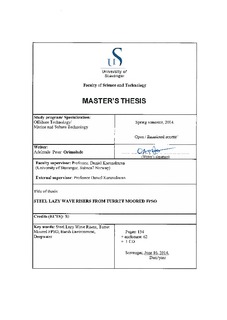| dc.description.abstract | This thesis work is focused on providing a suitable riser configuration for deployment in conjunction with a high motion floater in a remote, deepwater, harsh environment. This is justified by the rising demand for oil and gas, which is driving exploration and production into the deeper waters, and harsher environments.
Steel catenary riser (SCR) is a riser concept that is attractive for deep and ultra-deepwater developments; this is as a result of its capability to withstand the increasing external hydrostatic pressure with increasing water depths, its availability in larger diameters, and its suitability in high temperature and sour service conditions. However, this concept faces limitations for use in conjunction with a Floating Production Storage and Offloading (FPSO) system in deepwater, harsh environments.
An alternative configuration to the SCR is the steel lazy wave riser (SLWR); this configuration allows the FPSO motion to be decoupled from the touchdown point (TDP) of the riser. Some of the areas of interest that is addressed in this thesis work are the extreme and fatigue performance of the SLWR when hanged from a turret moored FPSO in a typical harsh environment.
The design basis was established using typical environmental and design data for offshore West of Shetland, and several analyses were performed to find an optimum configuration for the deepwater, harsh environmental condition. The integrity of the riser was checked in extreme sea state conditions, and detailed analyses were performed to establish the fatigue performance of the riser, considering both wave-induced fatigue and fatigue due to vortex induced vibration (VIV). In addition, detailed sensitivity studies were carried out to establish the extreme response behavior of the SLWR, by varying the main configuration parameters.
Overall, this thesis work showed that the SLWR is a suitable riser configuration for deployment in conjunction with turret moored FPSO in deepwater, harsh environmental conditions. The extreme strength response and wave-induced fatigue performance are satisfactory, however, fatigue damage due to VIV was above the acceptance level, and this will require the introduction of VIV suppression devices along some lengths of the riser. | nb_NO |

